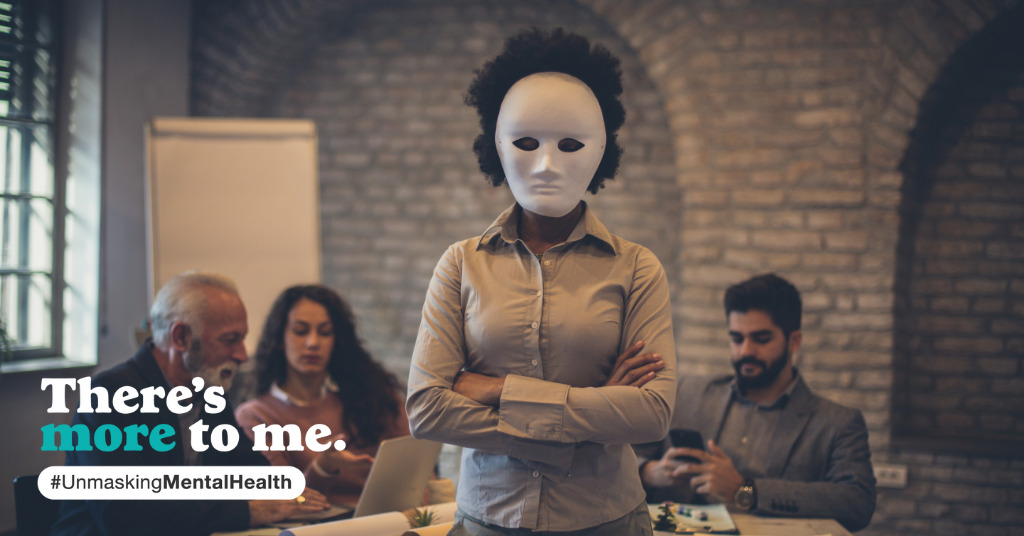Menu
Close

How to unmask at work and beyond
May 8, 2025
A guide to honouring your authentic self
Every day, countless people show up to work wearing invisible masks.
They smile through meetings, deliver results, meet deadlines, and make small talk—while quietly navigating struggles others may not see. This is masking and it’s more common than many workplaces realize. In fact, about three in four working Canadians wouldn’t tell their leader or coworkers about their mental illnesses.1
For Laura, masking was something she did most of her life without even realizing it:
At the end of the workday I was exhausted and had nothing left to take care of myself.
“At work I would spend all day being productive and masking my depression on top of my ADHD, so at the end of the workday I was exhausted and had nothing left to take care of myself. I didn’t want to clean or do laundry, even showering or brushing my teeth was a struggle, and I wasn’t eating well because I didn’t have the energy for meal planning, shopping and cooking. I would just finish work and collapse on the couch and then get up and do it all again the next day. Then on weekends I didn’t have any energy to socialize, even when I didn’t have to mask around my friends. I needed every moment of my weekend just to be able to perform the routine all over again the next week.”
The cost of masking
At work, people often mask to hide feelings of stress or burnout for fear of judgment about their performance but wearing that mask actually adds to existing stress.
I would hide my depressive episodes from people and avoided taking a leave because I didn’t want people to think I couldn’t do my job. Even when my doctor told me I should be taking a leave I kept going because I didn’t want it to impact my reputation at work.
It can also prevent others from truly seeing us—and supporting us. When we mask, we unintentionally teach people that we’re “fine,” even when we’re not. Over time, this can lead to feelings of isolation, disconnection, and burnout.
I eventually had to take a leave because my body was shutting down…
“…but even when I came back, although people knew why I was away, I put the mask right back on until I had another major depressive episode a few years later. That episode was the worst I’ve ever experienced and when I returned to work after it, I decided that people need to talk about this—I didn’t want anyone else to end up where I had. So, I talked more openly and offered to share my story.”
Why unmasking matters
It’s time we shed our masks and create a society where people feel safe and accepted. When employees don’t feel the need to hide who they are, they can engage more fully, build deeper connections and experience a stronger sense of belonging.2 By unmasking, we can:
Promote a culture of honesty and empathy: When people can speak openly about mental health, it sets the tone that it’s safe to be human at work. It gives others permission to do the same.
Foster healthier employees and teams: When someone feels safe enough to say, “I’m struggling,” they’re more likely to get the support they need—whether that’s flexible deadlines, mental health days, or accommodations. Getting that support helps them continue adding value in the workplace.
Prevent burnout before it’s too late: People who mask tend to overcompensate and push through, ignoring warning signs until they crash. Creating space for early conversations can help prevent this.
How leaders can create more accepting workspaces
But unmasking isn’t just on the individual—it’s deeply influenced by the environments we’re in. Whether you’re a manager, colleague, friend, or family member, here are some ways to help foster a culture of safety and openness:
Model transparency: Leaders set the tone. Sharing your own experiences with stress, burnout, or mental health challenges—even in small ways such as normalizing mental health check-ins during team meetings or 1:1s—creates space for others to do the same.
Establish psychological health and safety: It’s important to foster a supportive, productive, and resilient environment where employees can thrive. CMHA National offers evidence-based programs like Not Myself Today, Psychological Health and Safety Training, and custom workplace mental health training to equip leaders and employees with practical tools that support their mental well-being, and build a culture where everyone feels valued, understood, and empowered to get help when they need it.
Offer resources: Most workplaces now offer mental health supports and employee assistance programs to help people who may be struggling. Reminding employees of these resources and normalizing using mental health days, along with flexible scheduling, can help pave the way for change.
This Mental Health Week (May 5-11, 2025) let’s unmask mental health together and dismantle stigma and discrimination, so people feel safe to share and be who they really are.
For more information on masking or to download CMHA’s Mental Health Week toolkit, visit mentalhealthweek.ca.
References
1 Ipsos. (September 20, 2019). Mental illnesses increasingly recognized as disability, but stigma persists.
2 Canadian Centre for Diversity and Inclusion (CCDI). (2022). Toolkit: The Business Case for Diversity, Equity, and Inclusion.